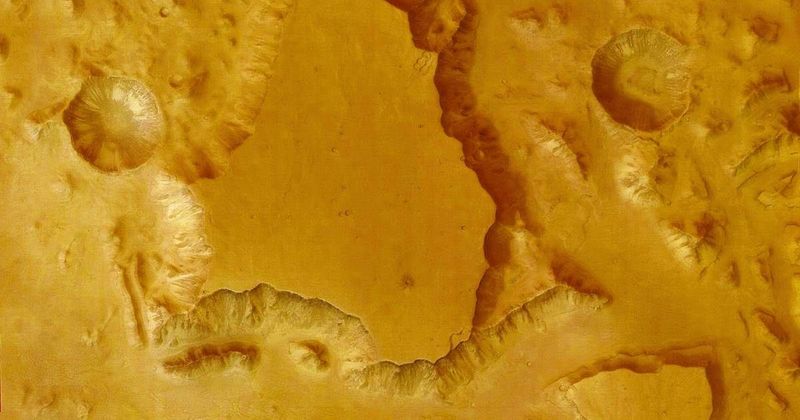While none of the interplanetary missions have found traces of life on Mars, both the Viking and China’s Zhurong rovers have discovered astonishing features of the Red Planet that could provide insights into its history and evolution. When Zhurong, China’s first-ever Mars landing mission, orbited the Red Planet for a year, it saw something surreal beneath the planet’s surface. Strange polygonal structures littered the layer of soil beneath the immediate surface. Researchers published a detailed study of these structures in the journal Nature Astronomy.

Zhurong, named after the Chinese “God of Fire,” was equipped with ground-penetrating radars. Using these radars, the spacecraft penetrated the soil of Utopia Planitia, the largest impact basin on Mars. In a layer 35 meters below the surface, they discovered 16 polygonal structures protruding from the ground, but buried deep in the upper layer of the soil. It took them completely by surprise. This particular terrain had previously been explored in 1976 by Viking 2, according to IFL Science.

A team of scientists from the Institute of Geology and Geophysics under the Chinese Academy of Sciences studied these structures in detail. The polygonal pattern of the terrain provided some interesting insights into the history of the planet, especially its climate.
When NASA’s Viking explored Mars, they discovered that Mars is a “cold planet with a volcanic soil.” It is much cooler than Earth and its atmosphere is mostly carbon dioxide. In the winter, CO2 freezes in the air and in the spring, it sublimates and blows upward in plumes of gas. Scientists studying the polygons believe that the “cool climate” and the “volcanic soil” are the two main factors behind these formations.

They proposed that these polygons were formed by freeze-thaw cycles that created cracks in the terrain when it was on the surface. They suggested that the wedges formed 3.7 to 2.9 billion years ago as a result of severe climate changes in Mars’ history. “The formation mechanism for the buried paleo-polygonal terrain requires a cold environment and could be related to water/ice freeze-thaw processes in the southern Utopia Planitia on early Mars,” the paper said. “The detected buried polygons, which indicate that freezing occurred at low to mid latitudes, require strong paleoclimatic variability.”

Previous work on the vertical terrain of this area indicated that there were several episodic floods that filled the basin about 3 billion years ago. This new study focused on how these layers look horizontally, across the 1.9 kilometers (1.2 miles) that these bizarre structures span. These wedges formed “possibly with the cessation of an ancient wet environment,” the researchers wrote.

Although this honeycomb of polygons is reminiscent of Earth’s “Giant’s Causeway,” a vast expanse of interlocking basalt columns, there is no evidence that the Martian polygons were formed by lava from volcanic activity. However, researchers considered the possibility that a volcano supported the formation of these wedges. However, it could not be proven either way. After analysis, the team is certain that the structures are sedimentary and were formed by thermal processes in varying climates. This indicates that this region of Mars must have experienced highly variable climatic conditions.

Another thing the rover picked up was that these polygons were buried in layers of material that looked completely different. They hypothesized that the earliest wet environment of Mars was the trigger for these geologic formations. “The subsurface structure with the capping materials covering the buried paleo-polygonal terrain suggests that a remarkable paleoclimatic transformation occurred sometime after that,” the researchers said.
Although these polygons surprised scientists because of their location, this discovery was not new to the radar. In 2012, NASA located several polygonal structures in the northern lowlands of the Red Planet. They too studied these structures and said that “scientists study polygonally shaped soil on Mars because the appearance and physical characteristics of the polygons help us understand the recent and past distribution of ice in the shallow subsurface and also provide clues to climate conditions.” But Zhurong is indeed the first to notice that the polygons lie “under” the topsoil.
